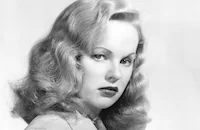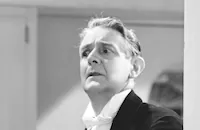Moss Rose
Cast & Crew
Gregory Ratoff
Peggy Cummins
Victor Mature
Ethel Barrymore
Vincent Price
Margo Woode
Film Details
Technical Specs

Synopsis
In the late 1800's, while traveling on a train, Belle Adair remembers the events that have brought her to this point: Belle is a dancer in the chorus of a London theater and lives at the same lodging house as her friend, Daisy Arrow. One night, after the show, Belle sees Daisy leaving in a hansom cab with an unidentified gentleman. The next morning, Belle notices a man leaving Daisy's room and finds Daisy dead, a rose on an open Bible beside her body. Police Inspector R. Clinner and Sergeant Evans tell the lodgers that Daisy was drugged and then smothered or strangled. Clinner, an amateur horticulturalist, notes that the rose is a moss rose, which requires an acidic soil and is currently out of season. Later that day, Belle, whose real name is Rose Lynton, talks to the cabby who drove the man she saw, and because the cabby knew her late father, a fellow cabby, the driver tells her that he took the man to the Regency Hotel. There, in the restaurant, Belle sees the man, Michael Drego, with his mother, Lady Margaret Drego, and his fiancée, Audrey Ashton. Michael is surprised that the women are in London and promises to join them in the country as soon as he can. Later, Belle goes to Michael's room and tells him that she saw him leave Daisy's room, but he denies knowing Daisy and thinks that Belle is trying to blackmail him. After Belle sees a newspaper announcement of the upcoming marriage of Michael and Audrey, she sends an anonymous letter to Inspector Clinner stating that Michael was involved in Daisy's murder. When Clinner questions him about his whereabouts on the night of the murder, Michael gives a false account. When asked to identify Michael, Belle denies ever having seen him, as he has indicated to her that he is prepared to meet her blackmail terms. When they meet the next day at an art gallery, Michael hands her an envelope containing cash, which she later returns to his hotel with a note that they must meet again. At the rendezvous on Waterloo Bridge, Belle tells Michael that what she really wants is to stay two weeks at his estate in Devonshire so that she can experience the life style of a lady, which is what she aspires to become. At first Michael refuses but when Belle threatens to implicate him further in Daisy's death, he agrees. Michael buys her new clothes and they go to Devonshire. Audrey tells Lady Margaret that she is very upset by Belle's presence, but Lady Margaret makes light of it, saying that Belle has done Michael a great favor, and receives her graciously. Later, Belle is caught snooping in a deserted child's room by an irate Lady Margaret, who explains that it was Michael's room before his father took him away to Canada for many years. Audrey reveals to Belle that she knows quite a bit of her personal history but wants to be her friend. When Audrey goes to London to buy her trousseau, Michael becomes more pleasant to Belle and she realizes that he does not love Audrey. Having ascertained from a local bookseller that Audrey recently bought three Bibles of the type found in Daisy's room, Clinner and Evans come to Devonshire to interrogate her. Clinner also asks to see the moss roses Lady Margaret grows in her greenhouse. After Belle receives a note from Clinner asking her to meet him at the village inn, Belle, afraid that she may incriminate Michael, decides to leave on the afternoon train. Michael talks her out of leaving and they both realize that they are in love. After Michael tells Audrey about his love for Belle, she accuses Belle of destroying her relationship with him. Later, Belle discovers Audrey dead, with a rose on an open Bible on her bedside table. At the coroner's inquest, it is established that Audrey died from an overdose of sleeping pills, which were apparently self-administered. As Clinner was not there, the local police find no significance in the presence of the rose and the Bible, but do hold Michael for questioning. When Clinner arrives, he sends for Belle, who in turn informs Lady Margaret that Clinner has told her that Michael has confessed to Audrey's murder. Lady Margaret realizes that Belle is truly in love with Michael and tries to reassure her. Before retiring for the evening, they drink some tea and Belle becomes very sleepy. When Lady Margaret tries to place a rose and a Bible in her room, Belle realizes that she killed Daisy and Audrey. Just as Lady Margaret is about to smother Belle with a pillow, Michael and several policemen break into the room. Back on the train, which will shortly be arriving in Toronto, where Michael will meet her, Belle realizes that Lady Margaret, now dead, wanted her son for herself.

Director

Gregory Ratoff
Cast

Peggy Cummins

Victor Mature

Ethel Barrymore

Vincent Price
Margo Woode

George Zucco
Patricia Medina

Rhys Williams
Carol Savage
Patrick O'moore

Billy Bevan
Michael Dyne
John Rogers
Charles Mcnaughton
Alex Frazer
Gilbert Wilson
Stanley Mann
Alex Harford
Sally Shepherd
Paul England
Colin Campbell

Leonard Carey
Norman Ainsley
Lee Macgregor
Philip Sudano
Basil Walker
Wallace Scott
Colin Kenny
Frank Baker
Doreen Munroe
Gerald Oliver Smith
Al Ferguson
Russ Clark
Francis Pierlot
Felippa Rock
Charlene Brooks
Jacqueline Warrington
Dorothy Schoemer
Eileen Robinson
Barbara Blain
John Goldsworthy
Major Sam Harris
Crew
Louis Bacigalupi
Leonardo Bercovici
Serge Bertensson
Niven Busch
David Buttolph
James B. Clark
Richard Day
Paul S. Fox
Jules Furthman
Roger Heman
Renè Hubert
Henrietta Kinnell
Mark-lee Kirk
Charles Le Maire
George Leverett
Thomas Little
Capt. Harry Lloyd Morris F.r.g.s.
Joe Macdonald
Gene Markey
Gene Markey
Alfred Newman
Ben Nye
Maurice De Packh
Edward Powell
Tom Reed
Ad Schaumer
Fred Sersen
W. Bertrand Stevens
Darryl F. Zanuck

Film Details
Technical Specs

Quotes
Trivia
Notes
According to documents in Twentieth Century-Fox Records of the Legal Department and Twentieth Century-Fox Produced Scripts Collection at the UCLA Arts-Special Collections Library, the studio purchased all rights to Joseph Shearing's novel Moss Rose from Chas. K. Feldman Group Productions in September 1946 for $200,000. (Joseph Shearing was a pseudonym for the prolific English writer Gabrielle Margaret Vere Campbell Long, who also wrote as George Preedy and Marjorie Bowen.) Feldman had bought the novel, through Universal, in 1943 for £2,250. As part of the deal with Feldman, Fox also acquired several screenplay adaptations which Feldman had commissioned from Jules Furthman, Tom Reed, Niven Busch and Leonard Bercovici. Writer James M. Cain assisted Busch with his screenplay but was not credited. The studio also agreed to lend independent producer Feldman one of their contract artists for one picture to be made by the end of 1948. Feldman requested options on Jeanne Crain, whom he wanted for The Glass Menagerie and A Streetcar Named Desire, Maureen O'Hara, Victor Mature, George Montgomery and John Payne. In the end, due to scheduling difficulties, this part of the deal was not realized.
On September 19, 1946, in a memo to producer Gene Markey and director Gregory Ratoff, executive producer Darryl F. Zanuck, having endorsed Peggy Cummins as the female lead, suggested Cornel Wilde for the male lead, Ethel Barrymore as the mother and Reginald Owen and Henry Daniell as the policemen. In a memo written on the same day to the studio's executive production manager, Ray Klune, Zanuck stated, "I am sure you can get all your sets from what we had in Cluny Brown, the street you are now building for Forever Amber and perhaps some of the sets from The Late George Apley.... Some of the streets that we used in Hangover Square and The Lodger (which I am sure are still standing on the back lot) will be perfect for this subject." By October 1946, Zanuck was suggesting Charles Laughton for the role of Inspector Clinner. Fox borrowed Patricia Medina from M-G-M for the production. After principal photography was completed, several major revisions, additions and excisions occurred. Studio records reveal that the following players, listed in Variety and Call Bureau Cast Service, appeared in scenes that were cut from the released film: Victor Wood, Tom Moore, Harry Allen, Clifford Brooke, Stuart Holmes and Connie Leon. It has not been possible to confirm the participation in the released film of John Goldsworthy and Major Sam Harris. Although their roles were eliminated, they May be visible in the backgrounds of certain sequences. The Production Encyclopedia erroneously credits Edwin B. Willis, head set decorator at M-G-M, as set decorator. The significance of the killer's "signature," a moss rose placed on an open Bible, is not explained in the film. This device did not come from the novel, whose title refers to a dance which Belle performs.












